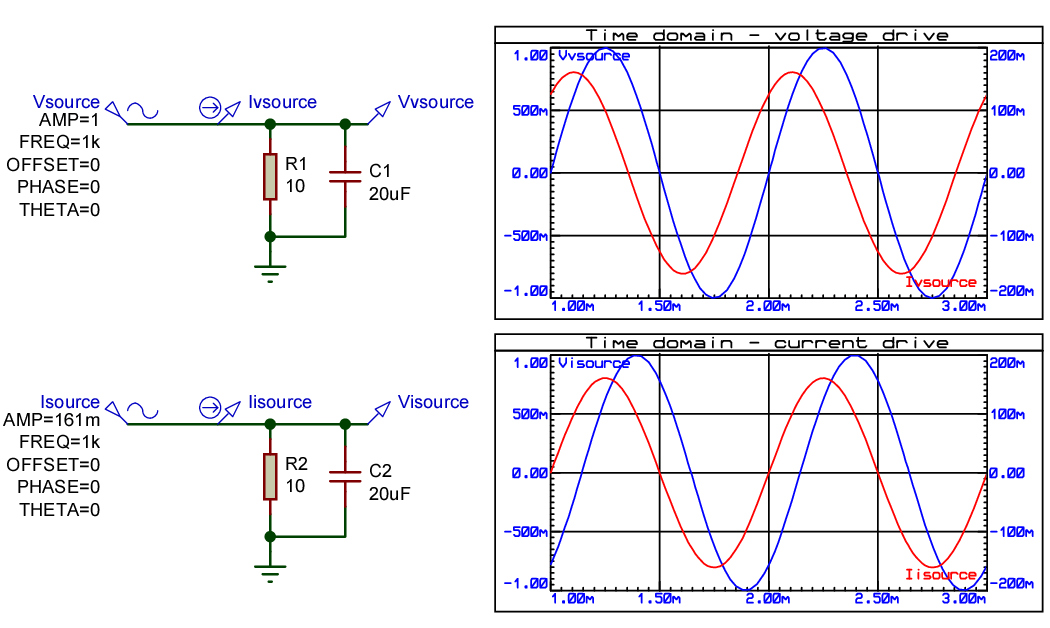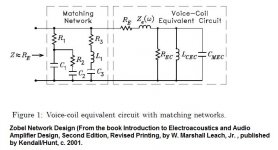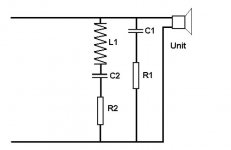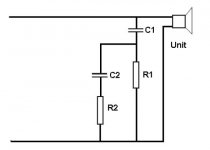Joe,
From my understanding the damping factor is just some smoke and mirrors left over from the days of matching output transformers and vacuum tubes and really has no real roll in speaker and SS amplifier interactions. It is a poor term at best. I'd have to go back and find the arguments against that thinking, that there is any real effect from so called damping factor, an old obsolete term.
As far as the conjugate network is concerned I have had this conversation with my own mentor and have been told multiple time that to get this truly correct requires an LCR tank circuit with exact values to counter the back emf. You can possibly leave out the resistor if you can match the resistance with the dcr of the coil but you can't leave out the capacitor or vs versa the inductor, the RC. Zobel network does not produce the same end result of countering the speaker parameters.
From my understanding the damping factor is just some smoke and mirrors left over from the days of matching output transformers and vacuum tubes and really has no real roll in speaker and SS amplifier interactions. It is a poor term at best. I'd have to go back and find the arguments against that thinking, that there is any real effect from so called damping factor, an old obsolete term.
As far as the conjugate network is concerned I have had this conversation with my own mentor and have been told multiple time that to get this truly correct requires an LCR tank circuit with exact values to counter the back emf. You can possibly leave out the resistor if you can match the resistance with the dcr of the coil but you can't leave out the capacitor or vs versa the inductor, the RC. Zobel network does not produce the same end result of countering the speaker parameters.
Last edited:
Straw man, please come in?
Please Jan. No more character assassinations, I can only die so many times.
Show where I denied that. And I don't think Steve has either. I would not mis-characterise your stance, only argue against it IF I did not agree.
I think Jan has been very clear about what you wrote that he disagrees with. You on the other hand alternately reiterate the same claim and deny having written it. Here it is:
Now I want to make a statement that I believe is an essential issue. The voltage source can produce current - no doubt about that - the problem is that it can also produce current of any phase angle. But a genuine current source can only produce a phase angle of zero since it sees it own output impedance as a series resistor of (ideally) infinite value. The voltage produced across the final load will always track current and voltage together without contamination.
How can you square that with the result of Jan's sim which clearly shows a load-dependent phase angle between current and voltage?
Snip...
How can you square that with the result of Jan's sim which clearly shows a load-dependent phase angle between current and voltage?
Easy. Jan's sim said that V=IZ. A complex load Z of 20uFand 10R, wasn't it? Complete with phase lag.
http://www.diyaudio.com/forums/multi-way/285062-joe-rasmussen-usher-s520-current-compatible-crossover-66.html#post4677993

Joe is talking about a corrected resistive load, hence V=IR. R is 8 ohms. There is no phase difference between current and voltage, however it is driven.
Easy. Jan's sim said that V=IZ. A complex load Z of 20uFand 10R, wasn't it? Complete with phase lag.
Joe is talking about a corrected resistive load, hence V=IR. R is 8 ohms. There is no phase difference between current and voltage, however it is driven.
Not even close. I see you snipped out Joe's words which said that the phase angle at the final load would be zero, and as you have admitted that is wrong.
Joe, here's the Impedance correction you wanted to see. The better Zobel. 
It's Marshall Leach who first did it AFAIK. Then Steen Duelund in a paper called Loudspeaker Impedance Correction. I think it's OK to show a small sample of copyright material, isn't it?
It's Marshall Leach who first did it AFAIK. Then Steen Duelund in a paper called Loudspeaker Impedance Correction. I think it's OK to show a small sample of copyright material, isn't it?
Attachments
Not even close. I see you snipped out Joe's words which said that the phase angle at the final load would be zero, and as you have admitted that is wrong.
Once again I am taken out of context and what I am saying is being cherry picked.
I say it again, a current amplifier sees its own output impedance first, then the load; if the ratio of that impedance to that of the load is high (the very essence of current driving), then what do you think the electrical phase angle is going to look like?
Enter a complete HIF design project file into SoundEasy, add a large value resistor on the input (amplifier's output), make that value many times the nominal impedance of the speaker, and plot the electrical phase angle. You can have resistors, capacitors and inductors, you can have wild frequency response, a whole lot of mess, but one thing you can bank on: The electrical phase angle will be flat... zero if the Z of the amp is infinite.
I mean, what the electrical phase angle of a resistor? Figure that out and you have your answer.
Since when is a direct quote "out of context"? I really don't know how it could be any more in context. And if you making incorrect claims about current amplifiers and saying that your claim is " essential" constitutes cherry picking, then I clearly don't understand the term.
I don't care whether you use a current source or a voltage source, when you drive that current or voltage into a complex impedance, then the phase angle at the final load will be non-zero. That is, there will be a phase difference between the voltage and the current at the reactive impedance. You clearly know this but very clearly (unusually for you) claimed the opposite.
I don't care whether you use a current source or a voltage source, when you drive that current or voltage into a complex impedance, then the phase angle at the final load will be non-zero. That is, there will be a phase difference between the voltage and the current at the reactive impedance. You clearly know this but very clearly (unusually for you) claimed the opposite.
I say it again, a current amplifier sees its own output impedance first, then the load; if the ratio of that impedance to that of the load is high (the very essence of current driving), then what do you think the electrical phase angle is going to look like?
See my basic math and Jan's sim. Whether you use current or voltage sources, the phase between voltage and current at the speaker driver is the same.
I think your error is that you're thinking of the voltage source in a Thevenin equivalent (voltage source in series with a resistor) as the amp, with the source impedance somewhere outside of it, rather than the amp being the series combination of the voltage source and the source impedance.
No, Joe, there's no war and no fog. You say you want an exchange of ideas, "brainstorming", but you very clearly want no such thing. Every time someone questions an idea you have put forward you snipe like you just did at me, and you evade, and you complain that people are out to get you, and you say you were misunderstood, and when confronted with your own words you say they mean something different. Like your specious claim that Kirchhoff's Law didn't apply. You claimed you didn't say it, then you claimed you were misunderstood, then you claimed you were a victim of character assassination, then finally admitted you said it but claimed you only said it to "lay a trap" for SY.
Now on page 1 of this thread you said something incorrect about current amps and phase angle:
"The voltage produced across the final load will always track current and voltage together"
Jan has already shown that to be false. Will you graciously admit you were mistaken? I confidently, but sadly, predict that you will not.
Now on page 1 of this thread you said something incorrect about current amps and phase angle:
"The voltage produced across the final load will always track current and voltage together"
Jan has already shown that to be false. Will you graciously admit you were mistaken? I confidently, but sadly, predict that you will not.
- Status
- Not open for further replies.
- Home
- Loudspeakers
- Multi-Way
- Joe Rasmussen Usher S520 "Current Compatible" Crossover



